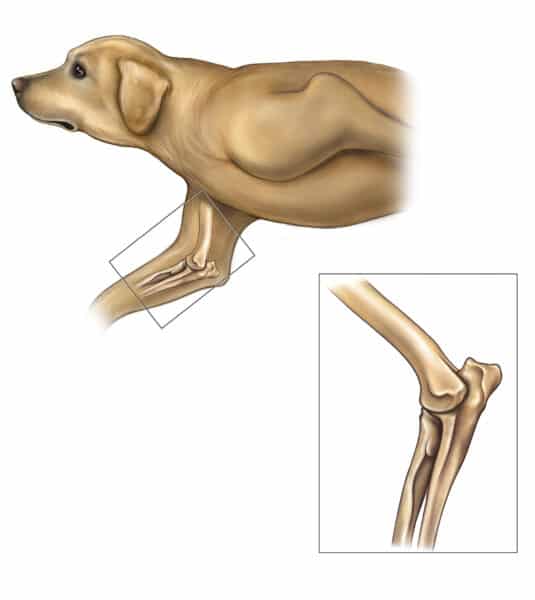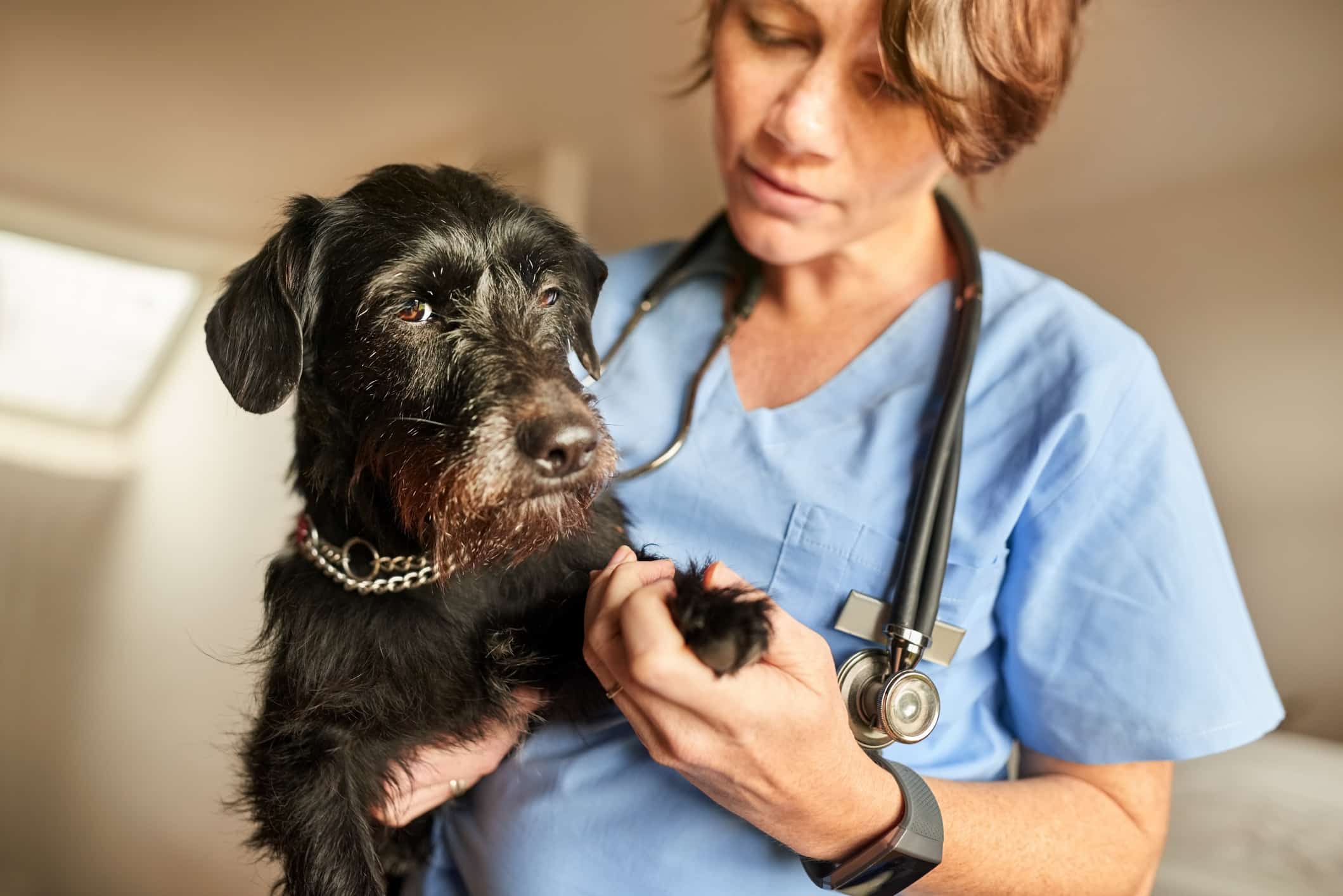Finding out that your dog has elbow dysplasia can feel absolutely devastating. Elbow dysplasia in dogs is hereditary, abnormal development of the elbow joint causing malalignment of the forelimb bones. Even if you don’t know exactly what elbow dysplasia looks like in your dog, you likely know that it’s incurable and can greatly impact your dog’s life. Understanding which dogs are more susceptible to elbow dysplasia, as well as symptoms, diagnostics and treatment options, will help you identify what’s happening with your dog more quickly, therefore changing their life expectancy and overall quality of life!
Some Dog Breeds Have a Higher Risk for Elbow Dysplasia
Educating yourself on which breeds are more susceptible to elbow dysplasia can be especially helpful during your initial search for the perfect dog. This information may veer you away from certain breeds, or change the medical criteria that you request before bringing your new family member home, such as requesting pre-adoption x-rays. These considerations should be processed with your lifestyle in mind, including what activities you’d like to share with your pup. Do you need your dog to be extremely active and agile? Are you comfortable with the possibility of this diagnosis? Will your pup be a working dog? How will this diagnosis change the way you and your dog live life together, and will the potential financial burden of this disease be manageable within your pet parent budget? Below is a list of breeds who are considered higher risk for elbow dysplasia:
- German Shepherd Dogs
- Labrador Retrievers
- Rottweilers
- Golden Retrievers
- Bernese Mountain Dogs
- Newfoundlands
Elbow dysplasia is a hereditary disease and medium to large breed dogs are more prone than smaller breeds. Dogs who become affected with this condition will likely display symptoms before their first birthday, meaning this is not a disease specific to senior dogs.
Signs of Elbow Dysplasia in Dogs

In order to understand the signs and symptoms of elbow dysplasia, it’s important to understand what happens to dogs with elbow dysplasia. Dogs with elbow dysplasia have abnormal pressure on the joint and wear and tear of the cartilage (cushion for the joint), which results in severe osteoarthritis. More often than not, both elbows are affected with this disease. Signs of elbow dysplasia in dogs include:
- The most common symptom for elbow dysplasia includes forelimb lameness or limping (the elbow joints are located on a dog’s front legs.) While some forelimb lameness will be easy to identify, subtle forelimb lameness can be trickier.
- Forelimb lameness will often be accompanied with some amount of head bobbing. This lameness may be more present after your dog has been physically active or gets up from sleeping.
- Low tolerance for long walks or high endurance exercise such as running or hiking.
- Reduced range of motion or flexibility at the elbow joint
- Dog experiences pain upon orthopedic examination
- Dog appears “stiff” when walking or getting up
If you are noticing these symptoms, have your pup seen by his veterinarian to determine next-steps.
Diagnosing Elbow Dysplasia in Dogs
If your veterinarian suspects elbow dysplasia in your dog, there will be a couple diagnostics that take place before a formal diagnosis can be made. These are:
1. Examination
The first diagnostic for symptoms associated with elbow dysplasia will almost always be a physical and orthopedic exam. During an orthopedic exam, your dog’s veterinarian will assess your dog’s flexion and extension capacity at each joint, looking for pain, swelling or loss of range of motion. This assessment should always be performed by a veterinarian! She may also perform a gait analysis, which includes watching the way your dog walks both away and toward your veterinarian.
2. Radiographic imaging
Once a thorough physical and orthopedic examination has been performed on your dog, and if elbow dysplasia is still suspected, your veterinarian will proceed with radiographic imaging. An X-ray can be performed while your pup is awake during the exam visit or your dog may require a mild sedation for proper positioning. Depending, your veterinarian may send the imaging to a board certified veterinary radiologist for diagnosis confirmation.
3. CT scan
Some types of elbow dysplasia may require further testing, including a CT (computed tomography) scan. This procedure collects a series of radiographs and then uses computer processing to provide in-depth information that is far more advanced than a standard radiograph. A CT scan will be significantly more expensive than radiographic imaging, usually costing between $1,500 and $2,000.
How to Manage Elbow Dysplasia in Dogs
There is no formal “cure” for elbow dysplasia. However, even though there’s no elbow dysplasia treatment, there are many non-surgical ways that you can support your pup in managing the disease. Here are four of them:
1. Therapeutic modalities
Modalities such as acupuncture, massage, laser or ultrasound therapy can help with primary and compensatory pain associated with your pup’s elbow dysplasia. In other words, these modalities help with identifying areas of the body that your pup may be overworking in order to compensate for his elbow pain, and aid in keeping the whole body sound and healthy.
Some ways that these elbow dysplasia therapeutic modalities help include:
- Identifying and reducing areas of inflammation
- Decreasing discomfort
- Providing improved flexibility and range of motion
- Increasing blood circulation and nutrients to muscles
- Reducing muscle wasting and atrophy
Many veterinary practitioners will offer one or more of the above modalities in their clinic. Additionally, there are many mobile practitioners popping up around the country who offer these services in the pet and pet parent’s home. Websites such as the American Holistic Veterinary Medical Association have search engines specifically for finding a practitioner in your town!
2. Hydrotherapy
Hydrotherapy is an excellent, low-impact exercise for dogs with elbow dysplasia! This is easily one of the least painful options for exercising these pups, and can be an excellent way to boost mental health for water dogs who enjoy swimming! Hydrotherapy helps to maintain strong and healthy muscle tone and reduces the onset of muscle wasting. It also improves range of motion and flexibility. Hydrotherapy options include dog pools, whirlpools or underwater treadmills.
3. Weight management
Weight management is critical for all dogs suffering from joint disease, including elbow dysplasia. Minimizing extra weight on the affected elbow joints is a relatively easy way to reduce pain and slow down the onset of joint degeneration and osteoarthritis.
Incorporating a manageable exercise routine that works well for your dog will be an important aspect to weight management. Exercising dogs with elbow dysplasia will vary depending on the severity of each dog’s case, overall health, experiences they find enjoyable and the pet parent’s own exercise tolerance and lifestyle. Even short walks twice daily are helpful in keeping extra weight off.
Monitoring caloric intake is another key component to weight management. Trading commercial treats for dehydrated vegetables such as carrots, sweet potatoes and green beans is a great way to implement low-fat, healthy treats into your pup’s daily routine. If your dog is highly food motivated, consider a food puzzle for dinner time, or even freezing their dinner in a Petsafe Chilly Penguin Freezable Treat Holder or Toppl for increased entertainment and mealtime longevity.
4. Diet therapy
While there are no specific diets to prevent or treat elbow dysplasia, certain diets are better than others for dogs with elbow dysplasia!
According to holistic veterinarian and Certified Canine Rehabilitation Therapist, Dr. Angie Krause, diets high in omegas are best for dogs with elbow dysplasia. Additionally, less processed diets will potentially reduce systemic inflammation, which is paramount for dogs suffering from joint disease. High-processed diets include kibble, whereas alternatives include canned food or even AAFCO balanced raw and home-cooked diets. High omega diets include salmon, anchovies or sardines.
Your dog did not develop elbow dysplasia because of anything you did wrong or incorrectly! This is a hereditary disease that was caused by genetic factors. You cannot change your dog’s diagnosis, but you can change the course of his life through careful monitoring and lifestyle adaptations.
Featured Image Credit: AJ_Watt/ Getty Images






